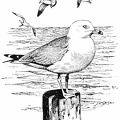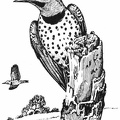Bubo virginianus
The Great Horned Owl, largest of the eared owls, is found over a wide area and may be either light or dark in color, depending on the area where he is found. All specimens show a white throat, ear tufts and yellow eyes. This bird is almost 2 feet in length and can handle fair-sized animals when pressed by hunger. The hoot of this bird is deeper, slower and more uniform than that of the Barred Owl, and often can be heard as a sort of conversational note between 2 birds in the same area. It is given as a 2-note “Who-who,” and answered by a similar call from another bird some distance away. These calls are given on a different pitch.
These owls nest early and often use old structures which were built by hawks, crows or eagles. Hollow trees or stone ledges furnish desirable locations. They are good parents and defend their home and young against all comers, including men. Crows and jays take delight in heckling these owls, but are careful to keep a safe distance, for Great Horned Owls see well in bright sunlight, altho they do most of their hunting in darkness. Their diet includes almost any type of animal life available, but rabbits, rats, squirrels and mice seem to be preferred. Some feed on starlings and pigeons which they find around city buildings.
- Author
- The Project Gutenberg EBook of Introduction to Our Bird Friends, Volume 2, by Lenwood Ballard Carson
Published 1957 - Posted on
- Wednesday 8 July 2020
- Dimensions
- 630*791
- Tags
- Birds
- Albums
- Visits
- 739
- Downloads
- 29
 Download Photo
Download Photo





